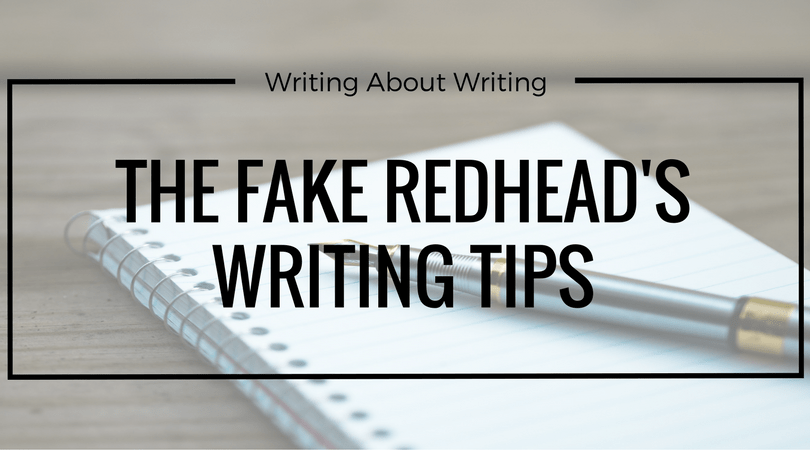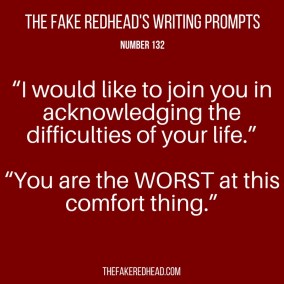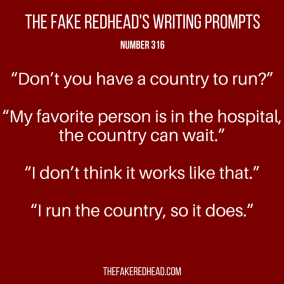Writing Tips | Find Your Next Favorite Book | Prompt Library | Shop The eBooks
Fight Scenes Are Hard, Yo
To answer the question I am assuming is on all of your minds, yes, everything is traumatic to my hyperbolic little mind.
Especially fight scenes.
There’s a lot to them, and that means that you run the risk of fumbling the execution, and that’s never fun.
But don’t let the fear that you’re going to mess up your fight scene stop you from writing one in the first place.
In fact, don’t let fear stop you from doing ANYTHING when it comes to writing. Just don’t. You don’t need that angst in your life.
Re-read those last three sentences a couple times.
Got it?
Awesome.
From my experience, the first step to writing a fight scene is getting into the mindset of writing a fight scene. The “Damn It, I Am Going To Write A Fight Scene Today” frame of mind, if you will.
Simple, right?
If you just sneezed while reading, that’s probably because you have a finely honed bullshit radar.
Here’s the truth:
Fight scenes aren’t the easiest things for some people (see: me!) to write and getting into the mindset isn’t any easier.
Sometimes, when you sit down and tell yourself that you’re getting into the “Damn It, I Am Going TO Write A Fight Scene Today” it doesn’t work and you end up … not doing that thing.
But like I said, don’t let that stop you.
If I did, I wouldn’t have finished the #WhoIsTalyaNightingale manuscript, and that would have been a very sad day.
Seriously, how could I write a novel about superheroes without fight scenes?
Of course, that doesn’t mean that the fight scenes in my first draft looked a lot like this:
AND THEN FIGHT HAPPENS. INSERT EVENTUALLY
I am a big fan of the concept of ‘eventually’.
But ‘eventually’ always comes, and when I needed to buckle down and finish the damn manuscript already, that meant I HAD to write out what happened in each of those scenes.
And the first draft of said fight scene doesn’t have to be perfect, but it DOES have to exist so that you can go back and MAKE it perfect.
I promise, one of these days, I’ll start in on that series on the benefits and importance of editing. It’s going to happen. Eventually!
See what I did there?
But anyway, back to fight scenes.
If you’re writing the kind of story where you need one or two or ten fight scenes, click the Continue Reading button on six ways to make writing them a little less traumatic.
1 Watch Your Favorite Fight Scenes For Inspiration
If you’re trying to right a fight scene (aka the reason you’re reading this post, unless you’re reading to see if I’m still crying about the Power Rangers movie. You won’t be disappointed if you keep reading either way), then odds are that you have at least some idea of the type of fight you’re trying to write.
Do you have a kick-ass female protagonist and you’re trying to envision her kicking major ass? Then hop on to the Hulu and catch some episodes of Alias for some Sydney Bristow-themed inspiration, because from 2001 to 2006, there were few female character as badass as Bristow.
On that same track, if you’re looking for a badass female who is fighting a larger male opponent, I HIGHLY recommend you watch Season One episodes 12 and 13, The Box: Part One and The Box: Part Two. Those episodes marked Quentin Tarantino’s first two of four appearances on the show, and the story arc culminates with Jennifer Garner’s Bristow kicking some serious butt before the CIA comes to her not-entirely-needed-aid.
Remember when the likes of Bradley Cooper and Greg Grunberg were on Alias? Talk about throwback.
Or are you looking for badass with a little less gun violence? Remember when I said that from 2001 to 2006, there were few female characters as badass as Bristow?
(It was literally two paragraphs ago) Anyway, Sarah Michelle Gellar’s Buffy Summers was one, so in honor of the show’s 20th anniversary, dust off your old VHS tape collection (or go onto Netflix, you do you) and watch some old episodes of Buffy the Vampire Slayer. Not Season Six’s Seeing Red, obviously, or the season for episodes with the grenade launcher, but you know what I mean.
Plus, Buffy features lot of awesome puns, and I am a BIG fan of puns.
Want MORE hand-to-hand combat? Try Pacific Rim. (Which, BTW was INCREDIBLY underrated and when I first saw it in theaters the opening sequence almost made me cry, because it was like Power Rangers, but you know, real—before they announced that the Power Ranger reboot was actually happening, of course. Have I mentioned yet how happy I still am about that movie? No? Well I am.)
Anyway, back to the point, try the scene where Charlie Hunnam’s Raleigh Becket and Rinko Kikuchi’s Mako More have their fight in the middle of Raleigh’s audition for his new Jaeger drift partner.
Trying to envision an even BIGGER battle?
Then head on over to the second and third movies in the Lord of the Rings trilogy. They have all sorts of battles at every scale for you to draw inspiration from, including the comparatively mid-sized battle at Helm’s Deep to the big ass final fight in front of the city of Gondor. Want smaller scale but still fantasy? Try Eowyn’s fight against the Witch King, Frodo’s fight against no one’s favorite giant spider, or even his final battle with Gollum in Mount Doom? They even have a fighting ghost army, so basically there’s a fight scene for everyone.
I could go on, but I also don’t have time to spend a week and 10,000 words on fight scenes.
2 Pick Up The Pace
So you’ve imagined what kind of fight scene you want to write, what do you do next?
Short sentences. Fragmented thoughts. Things coming from out of nowhere. Un-expecting bystanders.
A fight scene is like a puzzle, and not one of those giant, 24-piece mat puzzles of your nieces’ favorite Disney princess, but a 1000-piece puzzle where each piece is no bigger than a quarter.
Instead of looking at the bigger picture, like you would for say, introducing your story’s setting, when you’re writing your fight scene, you want to focus on the small things, and you don’t want to spend too much time on each element.
You want to keep things moving to encourage your readers to keep turning the page, and you want to constantly keep them guessing. Throw your protagonist down onto their back. Make your readers think they’re about to be maimed. Or just straight-up maim them anyway. It’s your story, you do you.
But do it quickly.
Punching someone in the face doesn’t take very long, so it shouldn’t take up half a page of description.
Look back to Tip One, and take the fight scene that’s inspired you and see how long it takes to go from beginning to end. Obviously, these fights are cut in a certain way for dramatic effect and time constraints, and while ‘time constraints’ don’t necessarily apply to a novel in the same way, you want to be thinking about how much time you’re spending in the fight.
Because, like I said, you want to keep your readers moving through the story, you don’t want them to get bored and put the book down.
3 Let The Environment Work For Or Against Your Protagonist
Let’s talk about Marvel for Netflix. Specifically, let’s talk about Daredevil, Jessica Jones, and Luke Cage.
And let’s NOT talk about Iron Fist, unless we’re talking about anyone OTHER Danny Rand and the knock-off Arrow big business whatever (yeah, I’m bullshitting on that one. Haven’t watched it and I’m not planning to. Also, if I wanted to watch it, but good, I’d seriously just watch Arrow Season One again.)
Anyway, when Daredevil was released, it was released with a BANG and the talk of the town (or the Internet, really) was that epic fight scene in the middle of a crowded hallway.
Daredevil, along with Jessica Jones (which was SUPER messed up in all the best ways), and Luke Cage all featured well-choreographed fight scenes where the protagonists used their environment to their advantage.
On the flip side, you can also use your environment as a DISadvantage.
Have you ever been thrown into a pool while fully dressed and then tried to walk around afterward? Not so easy, right? Or you’ve been caught in a monsoon without an umbrella and have to slog from one end of campus to the other with all your stuff.
Not easy, is it?
So if that’s not easy, then fighting while soaking wet can’t be easy either.
Or is your character running through a forest? That brings in another whole host of problems, because if they’re being pursued by, let’s say a bear, because I’m in the mood to make a bad Shakespeare joke, then not only are they going to have to focus on what’s behind them, but what’s in front of them.
Wouldn’t it suck for your character if they were knocked out by a tree limb they didn’t see and therefore didn’t duck under, and then they were gored by said pursuing bear and eaten?
Yeah. That wouldn’t fun for them.
4 Use Your (Character’s) Senses
You know that feeling you get in the back of your throat when you run, the one where you taste blood whenever you swallow?
Show your character feeling that.
Remember how you’d get a stitch in your side while running when you were in elementary school and you felt like you were dying? (Couldn’t have just been me who felt that).
Show your character feeling that.
Ever held your breath so long you got dizzy?
Not recommended, but show your character feeling that. It’s important for you to remember that what your character is going through is TOUGH on their body. Fights are no joke, that’s why we as normal-isa people tend to avoid them.
But you can use what you know of physical exertion and what you’ve seen of fights from shows and movies and comics you love, and take that and put it into what you’re working on.
5 Listen To Fast-Paced Music/Soundtracks/Cinematic Scores
It should come to absolutely zero surprise that the only thing I’ve been listening to since seeing the Power Rangers movie is the cinematic score by Bryan Tyler.
And while not all of it is the rollicking, fast-paced music featured in the climactic battle scenes or the cow-featuring car chase from the beginning of the movie (which I talked about HERE when both crying over the movie and talking about how to start your story), the basis of each song is in the realm of ‘fast’, and that can get you motivated the same way.
So in the same vein of my unique sources of background noise post, find your favorite fast-paced music and play it on repeat as you write. It’ll put you in that “Damn It, I Am Going To Write A Fight Scene Today” mindset and will also draw you back into some of your other favorite fight scenes while you write.
And that will all help you convey the violence and action you’re looking to convey into your story.
(On a side note, another effect of listening to fast-paced music, is that you type very quickly too. Do the same and you’ll see what I mean.)
Also, go see Power Rangers. I promise I’m not steering you wrong.
6 Complain Having About Having To Write Them On Social Media
Now, it would take too long to find the specific tweets, but around the time that I was finishing the second or third draft of the #WhoIsTalyaNightingale manuscript, most of my Twitter timeline was about how much fight scenes piss me off.
Because they’re not easy, and this story was really one of the first stories that I’ve completed to the point where I’d need to get down to the nitty gritty of something like a fight scene. Or multiple fight scenes, as is the case.
So, like I said in my very first writing tips post, talk about what you’re doing (or trying to do, as it were) on social media. Not only will you get the accountability you need to finish your work via your friends and following, but sometimes when you get the angst of not loving what you’re doing out of the way, it’s easier to focus.
So go forth my fellow writers, and kick the crap out of that fight scene.
Check Out The Last Writing Tip Check Out The Next Writing Tip
Shop The eBooks | Find Your Next Favorite Book
Want more prompts? Check out the Prompt Library.
Do you have a question about writing that you want me to answer? Leave a comment below! (I’m also answering questions in the Facebook group. Hop on over and say hi!)







This is so great!! I’ve been having to write a few fight scenes, and I actually rather like writing them… but you have great tips, and your humor is superb. (And listening to intense soundtrack really does make you type faster, just saying…)
Happy to help! I am not kidding when the major fight scenes of my manuscript were the most difficult parts of the entire thing! Best of luck!
Hi there! Per your earlier permission, I scheduled this article to be featured as a guest post on http://www.ryanlanz.com on June 23rd. As usual, it has your credit/bio/link. Thanks!
Great! Thanks!